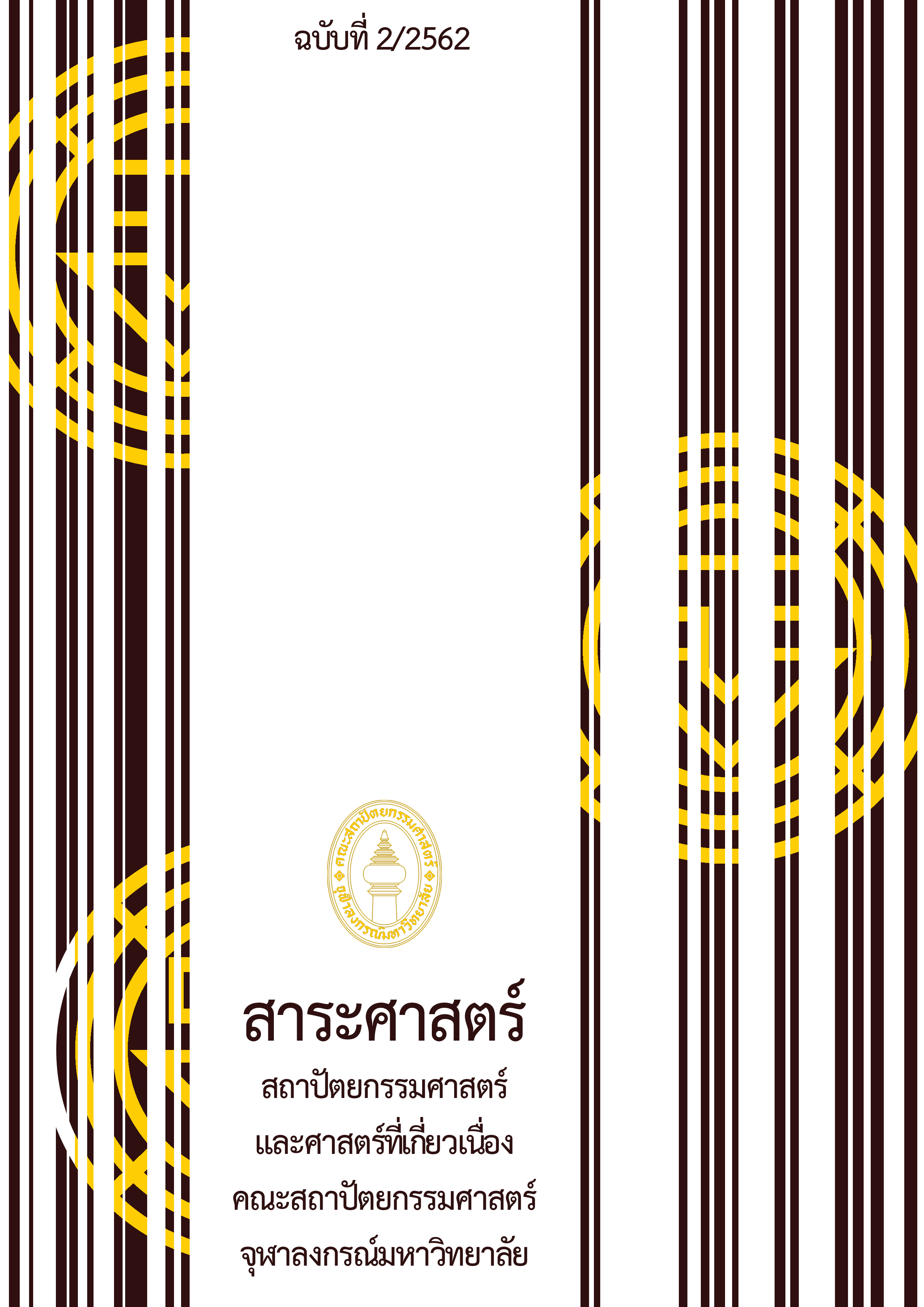Evolution of Open Space Planning of Singapore HDB Housing Projects during 1960-2018
Main Article Content
Abstract
Singapore’s housing policies have changed with its building designs over the decades since it was established. This can be clearly seen from the design of open spaces in recent HDB (Housing and Development Board) projects which have different designs from the projects built in 1960, when the HDB was just established. This qualitative research aims to study open space planning in HDB residential projects and its relationship with public housing policies during the different ages, and to glean some insights on how to improve residential development organization in Thailand.
The research begins by dividing the development periods between 1960 and 2018 and studying its relevant housing policies. Thereafter, four distinct housing projects and their open space layouts are analysed for their relationship with the policies in its respective period. Finally, we conclude with the lessons learned.
In summary, this study states that: (1) Housing policies can be divided into four distinct periods (1.1) The Government under Prime Minister Mr. Lee Kuan Yew's leadership can be divided into two time periods - the Age of Housing Shortage that resulted in straightforward open spaces to allow HDB to build as many housing units in the shortest time and lowest budgets possible, and; (1.2) The Age of Community Building, where buildings in housing projects were arranged in clusters to form courtyards between blocks, allowing the creation of communal spaces where residents could dwell and interact. (1.3) The Government under Prime Minister Mr. Goh Chok Tong's leadership, which was the Age of House Ownership. Housing was seen as assets for owners hence the concept of multi-storey carpark (MSCP) and roof gardens was introduced. (1.4) The Government under Prime Minister Mr. Lee Hsien Loong's leadership (at present), when HDB aims to develop housing under “City in a Garden” concept. Underground parking is introduced with the environmental deck on top as open space for usage. (2) Open space planning in each period is always relevant to concepts of “Garden City” and “City in a Garden” which is Singapore’s core green policy. It is noted that although residential densities have risen over decades due to limited land resources, at the same time, open space ratio per housing site has also increased.
As such, we can see that open space planning in HDB projects is integral to the success of housing policies introduced in each period and the country’s physical development concept. This is helpful to improving the development of residential projects in Thailand, with lessons on project planning and design following development policy. These are factors that can lead to better project successes.
Article Details
References
Square Medan.” Procedia-Social and Behavior Sciences 36 (December 2012): 466-475.
Annual Report 1960-2018. Singapore: Housing and Development Board, n.d.
Central Intelligence Agency. “The World Factbook Archive: Singapore.” Accessed April 1, 2019. https://
www.cia.gov/library/publications/the-world-factbook/geos/sn.html.
Chan, D. 50 Years of Social Issues in Singapore. Singapore: World Scientific Publishing, 2015.
Chia, L. “Kampung Admiralty a 'Model for Future Public Housing': Lee Hsien Loong in National Day Message.” Channel News Asia (8 August 2018).
Chua, B.H. Political Legitimacy and Housing – Stakeholder in Singapore. London: Routledge, 1997.
Goh, L.P. et al. Public Housing in Singapore: Social Well-Being of HDB Communities: Sample Household Survey 2013. Singapore: HDB Research and Planning Group, 2014.
Hee, L.M. “Singapore’s Public Housing Spaces – Alter-‘Native’ Spaces in Transition.” In Dissent and Cultural Resistance in Asia’s Cities, 71-91. Oxon: Routledge, 2009.
Housing and Development Boards. “About Us.” Accessed February 20, 2019.
https://www.hdb.gov.sg/cs/infoweb/about-us.
Housing and Development Boards.“Greenprint.” Accessed February 10, 2019.https://www.hdb.gov.sg/cs/infoweb/about-us/our-role/smart-and-sustainable-living/hdb-greenprint&rendermode=preview.
Housing and Development Boards. “HDB Map Service.” Accessed February 2, 2019. https://services2.hdb.gov.sg/web/fi10/emap.html.
Housing and Development Boards.“Remaking Our Heartland.” Accessed February 20, 2019.https://www20.hdb.gov.sg/fi10/fi10349p.nsf/hdbroh/index.html.
Housing and Development Boards.“Smart HDB Town.” Accessed February 20, 2019.
https://www.hdb.gov.sg/cs/Satellite?c=Page&cid=1383805555648&
pagename=InfoWEB%2FPage%2FArticleDetailPage&rendermode=preview.
Housing – Turning Squatter into Stakeholder. Singapore: Cengage Learning, 2013.
Liu, T.K. “Transforming a City: The Singapore Experience.” Paper presented at Hong Kong Convention
& Exhibition Centre, 10 June 2016.
Ng, L. “City in a Garden.” ETHOS, June 14, 2008.
Phang, S.Y. and Kim, K.H. Singapore’s Housing Policies: 1960-2013. Singapore: Research Collection
School of Economics, Singapore Management University, 2013.
Shi, M.Y., and Tien, F.S. “Government’s Role in Housing: The Case of Singapore.” Housing Finance
International (Autumn 2016): 25-30.
Siew, E.T., and Kong, L. Public Housing in Singapore: Interpreting 'Quality' in the 1990s. Singapore: Research Collection School of Economics, Singapore Management University, 1997.
“Text of Mr Teh Cheng Wan's Speech at the Forums on HDB Policy.” The Straits Times, January 15, 1983.
Wong, A.K., and Yeh, S.H.K. Housing a Nation 25 Years of Public Housing Singapore. Singapore: Maruzen Asia for Housing & Development Board, 1985.
Yuen, B., Ho, P.T., and Giok, L.O. Singapore Housing: An Annotated Bibliography. Singapore: NUS Press, 1999.


